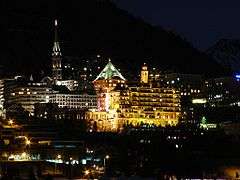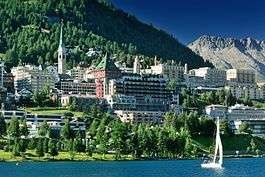St. Moritz
| St. Moritz | ||
|---|---|---|
|
View of luxury five-star hotels from lake in July 2014 | ||
| ||
 St. Moritz | ||
|
Location of St. Moritz  | ||
| Coordinates: 46°30′N 9°50′E / 46.500°N 9.833°ECoordinates: 46°30′N 9°50′E / 46.500°N 9.833°E | ||
| Country | Switzerland | |
| Canton | Grisons | |
| District | Maloja | |
| Area[1] | ||
| • Total | 28.69 km2 (11.08 sq mi) | |
| Elevation (Traunter Plazzas) | 1,822 m (5,978 ft) | |
| Population (Dec 2015[2]) | ||
| • Total | 5,067 | |
| • Density | 180/km2 (460/sq mi) | |
| Demonym(s) | German: St. Moritzer(in) | |
| Postal code | 7500 | |
| SFOS number | 3787 | |
| Localities | St. Moritz-Dorf, St. Moritz-Bad, Suvretta, Champfèr (eastern part) | |
| Surrounded by | Bever, Celerina/Schlarigna, Samedan, Silvaplana | |
| Website |
www SFSO statistics | |
St. Moritz (German: Sankt Moritz; French: Saint-Moritz; Romansh: ![]() San Murezzan ; Italian: San Maurizio) is a high Alpine luxury resort in the Engadine in Switzerland, at an elevation of about 1,800 metres (5,910 ft) above sea level. It is Upper Engadine's major village and a municipality in the district of Maloja in the Swiss canton of Graubünden.
San Murezzan ; Italian: San Maurizio) is a high Alpine luxury resort in the Engadine in Switzerland, at an elevation of about 1,800 metres (5,910 ft) above sea level. It is Upper Engadine's major village and a municipality in the district of Maloja in the Swiss canton of Graubünden.
St. Moritz lies on the southern slopes of the Albula Alps below the Piz Nair (3,056 m (10,026 ft)) overlooking an astoninglishly flat and quite wide valley with a lake of its own name at its feet: Lej da San Murezzan (Romansh for Lake of St. Moritz). It hosted the Winter Olympics in 1928 and 1948.
St. Moritz is a popular destination for the upper class and international jetset. It is also regarded as the most expensive ski resort in the world, with many luxurious five star hotels and upscale shops.
History

Votive offerings, swords, and needles from the Bronze Age found at the base of the springs in St. Moritz indicate that the Celts had already discovered them.
St. Moritz is first mentioned around 1137–39 as ad sanctum Mauricium.[3] The village was named after Saint Maurice, an early Christian saint from southern Egypt said to have been martyred in 3rd century Roman Switzerland while serving as leader of the Theban Legion.
Pilgrims traveled to Saint Mauritius often to the church of the springs, where they drank from the blessed, bubbling waters of the Mauritius springs in the hopes of being healed. In 1519, the Medici pope, Leo X, promised full absolution to anyone making a pilgrimage to the church of the springs. In the 16th century, the first scientific treatises about the St. Moritz mineral springs were written. In 1535, Paracelsus, the great practitioner of nature cures, spent some time in St. Moritz.
Although it received some visitors during the summer, the origins of the winter resort only date back 151 years ago to September 1864, when St. Moritz hotel pioneer Caspar Badrutt made a wager with four British summer guests: they should return in winter and, in the event that the village was not to their liking, he would reimburse their travel costs. If they were to find St. Moritz attractive in winter, he would invite them to stay as his guests for as long as they wished.[4] This marked not only the start of winter tourism in St. Moritz but the start of winter tourism in the whole of the Alps. The first tourist office in Switzerland was established the same year in the village. St. Moritz developed rapidly in the late nineteenth century; the first electric light in Switzerland was installed in 1878 at the Kulm Hotel, and the first curling tournament on the continent was held in 1880.[4] The first European Ice-Skating Championships were held at St. Moritz in 1882 and first golf tournament in the Alps held in 1889. The first bob run and bob race was held in 1890. By 1896, St. Moritz became the first village in the Alps to install electric trams and opened the Palace Hotel.[4] A horse race was held on snow in 1906, and on the frozen lake the following year. The first ski school in Switzerland was established in St. Moritz in 1929.[4]

St. Moritz hosted the 1928 Winter Olympics, the stadium still stands today, and again in 1948. It has hosted over 20 FIBT World Championships, three FIS Alpine World Ski Championships (1934/1974/2003) and over 40 Engadin Skimarathons since 1969. It has also hosted many other events since, including some unlikely ones on the frozen lake in the 1970s and 1980s such as a golf tournament, (1979), a polo tournament (every year in February starting in 1985) and cricket (1989).[4] St. Moritz has also been the venue for many Sailing and Windsurfing World Championships.
Since the early 1980s St. Moritz is also promoted and known as Top of the World. The expression was registered as a trademark by the tourist office in 1987.
Between 9–12 June 2011, St. Moritz was the site of the Bilderberg Group conference, an annual, unofficial, invitation-only conference of approximately 120 to 140 guests from North America and Western Europe, most of whom are people of influence.
Geography

St. Moritz has an area of 28.7 square kilometers (11.1 sq mi), as of 2006. Of this area, 28.2% is used for agricultural purposes, while 19.4% is forested. Of the rest of the land, 8.3% is settled (buildings or roads) and the remainder (44.1%) is non-productive (rivers, glaciers or mountains).[5]
The highest summit in the Eastern Alps is Piz Bernina at 4,048.6 m (13,283 ft), located 15 km (9 mi) southeast of the village.
The municipality is located in the Oberengadin sub-district of the Maloja district. It consists of the settlements of St. Moritz-Dorf (elev. 1,830 m (6,005 ft)), Bad (1,775 m (5,825 ft)), Champfèr (1,825 m (5,990 ft)), and the village section of Suvretta.
Sport


St. Moritz has been a resort for winter sport vacations since the 19th Century. Students from Oxford and Cambridge went there to play each other – the predecessor of the recurring Ice Hockey Varsity Match was a bandy match played in St. Moritz in 1885. St. Moritz was the host city for the Winter Olympic Games in 1928 and 1948, one of three cities to host twice, along with Innsbruck, Austria and Lake Placid in the United States. It also hosted the world championships for alpine skiing in 1934, 1974, and 2003; they are scheduled to return in February 2017.
Additionally, St. Moritz has hosted the FIBT World Championships (bobsleigh and skeleton racing) a record 21 times. Since 1985, it has hosted the Cartier Polo World Cup on Snow; an annual high-goal tournament featuring many of the world's finest teams. In its current form, the it lasts four days and is played on a specially-marked field on the frozen lake.[6]
St. Moritz is extremely popular in the summer months as an altitude training base for distance athletes, particularly cyclists, runners, and race walkers. Its popularity extends to the altitude, weather, world class athletics track, and availability of paths and trails in the area.
In 1904, the oldest and world's last remaining natural bob run was opened. The 1.72 km (1.07 mi) ice channel – also known as the world's biggest "ice sculpture" – is built every winter from the ground up with only snow and water. The bob run hosted numerous world championships and was used in both Olympic Winter Games. In the early 1930s, some members of the bob club started taking guests along for taxi rides; today they run with slightly modified racing bobs.
For the 1928 games, the cross-country skiing and the cross-country skiing part of the Nordic combined events took place around the hills of St. Moritz.[7] Twenty years later, once again the cross-country skiing, the cross-country skiing part of the Nordic combined, and the ice hockey events took place in St. Moritz.[8]
by David Wynne (1985)
In addition to the above sports, St. Moritz is also well known as a destination for sailing. It is the host venue for the annual St. Moritz Match Race held on lake St. Moritz. The St. Moritz Match Race event is part of the prestigious World Match Racing Tour which covers 3 continents. The event draws the world's best sailing teams to St. Moritz in a gladiatorial battle of nerve and skill on the water. The identical supplied (BLU-26) boats are raced two at a time in an on the water dogfight which tests the sailors and skippers to the limits of their physical abilities. Points accrued count towards the World Match Racing Tour and a place in the final event, with the overall winner taking the title ISAF World Match Racing Tour Champion. Match racing is an ideal sport for spectators in St. Moritz. Racing in such close proximity (approximately 15 m) to the Lake St. Moritz shoreline provides excellent heart of the action viewing for the audience.
Tourism
Thanks to its favorable location, St. Moritz enjoys over 300 days of sunshine a year. Every winter it hosts the "White Turf" horse race on the frozen Lake St. Moritz attended by the international upper class.
Popular pastimes include skiing, snowboarding, and hiking, and nearby there is also the world-famous Cresta Run toboggan course.
The year-round population is 5,600, with some 3,000 seasonal employees supporting hotels and rental units with a total of 13,000 beds.
Main sights

and St. Moritz library
- The Segantini Museum: dedicated to Giovanni Segantini, a painter that lived the last five years of his life in Engadine. The Segantini Museum is listed as a Swiss heritage site of national significance.[9]
- The bobsled run: a very rare all-natural venue, typically open by mid-December
- Viewing the glacier landscape: there are a number of notable vistas. Much can be seen by descending from Diavolezza to the Morteratsch Glacier.
- The 3,300 m (10,800 ft) Piz Corvatsch with its ice cave and its lengthy 8 km (5 mi) piste down to St. Moritz-Bad.
Climate
St Moritz has a subarctic climate only just above alpine/polar due to its elevation with cold, moderately snowy winters and mild, wet summers.
| Climate data for Climate normals Samedan (Reference period 1981−2010) | |||||||||||||
|---|---|---|---|---|---|---|---|---|---|---|---|---|---|
| Month | Jan | Feb | Mar | Apr | May | Jun | Jul | Aug | Sep | Oct | Nov | Dec | Year |
| Average high °C (°F) | −1.6 (29.1) |
0.5 (32.9) |
3.7 (38.7) |
7.4 (45.3) |
12.9 (55.2) |
16.4 (61.5) |
19.3 (66.7) |
18.7 (65.7) |
14.9 (58.8) |
10.9 (51.6) |
3.7 (38.7) |
−1.2 (29.8) |
8.8 (47.8) |
| Daily mean °C (°F) | −9.1 (15.6) |
−7.8 (18) |
−2.8 (27) |
1.6 (34.9) |
6.6 (43.9) |
9.9 (49.8) |
12.2 (54) |
11.5 (52.7) |
7.9 (46.2) |
3.8 (38.8) |
−2.7 (27.1) |
−7.5 (18.5) |
2.0 (35.6) |
| Average low °C (°F) | −16.3 (2.7) |
−16.4 (2.5) |
−10.4 (13.3) |
−4.7 (23.5) |
−0.1 (31.8) |
2.5 (36.5) |
4.3 (39.7) |
4.0 (39.2) |
1.0 (33.8) |
−2.9 (26.8) |
−8.9 (16) |
−13.8 (7.2) |
−5.1 (22.8) |
| Average precipitation mm (inches) | 28 (1.1) |
20 (0.79) |
26 (1.02) |
39 (1.54) |
78 (3.07) |
90 (3.54) |
93 (3.66) |
99 (3.9) |
73 (2.87) |
68 (2.68) |
61 (2.4) |
36 (1.42) |
713 (28.07) |
| Average snowfall cm (inches) | 51.8 (20.39) |
38.9 (15.31) |
32.5 (12.8) |
23.5 (9.25) |
6.3 (2.48) |
0.6 (0.24) |
0.3 (0.12) |
0.3 (0.12) |
1.2 (0.47) |
8.1 (3.19) |
40.8 (16.06) |
49.9 (19.65) |
254.2 (100.08) |
| Average precipitation days (≥ 1.0 mm) | 5.3 | 4.2 | 4.8 | 6.0 | 9.3 | 10.3 | 10.0 | 10.5 | 7.8 | 7.6 | 7.0 | 6.0 | 88.8 |
| Average snowy days (≥ 1.0 cm) | 9.1 | 7.4 | 7.6 | 5.8 | 1.5 | 0.3 | 0.1 | 0.1 | 0.6 | 2.0 | 6.8 | 9.1 | 50.4 |
| Average relative humidity (%) | 77 | 73 | 70 | 69 | 69 | 69 | 70 | 73 | 74 | 75 | 77 | 79 | 73 |
| Mean monthly sunshine hours | 117 | 122 | 140 | 138 | 158 | 176 | 200 | 180 | 154 | 140 | 106 | 103 | 1,733 |
| Percent possible sunshine | 58 | 58 | 53 | 47 | 46 | 49 | 57 | 57 | 58 | 58 | 52 | 53 | 53 |
| Source: MeteoSchweiz [10] | |||||||||||||
Demographics
Population
St. Moritz has a population (as of 31 December 2015) of 5,067.[2] As of 2008, 38.0% of the population was made up of foreign nationals.[11] Over the last 10 years the population has decreased at a rate of 4.9%.[5]
As of 2000, the gender distribution of the population was 45.4% male and 54.6% female.[12] The age distribution, as of 2000, in St. Moritz is; 423 children or 7.6% of the population are between 0 and 9 years old and 502 teenagers or 9.0% are between 10 and 19. Of the adult population, 960 people or 17.2% of the population are between 20 and 29 years old. 1,055 people or 18.9% are between 30 and 39, 864 people or 15.5% are between 40 and 49, and 820 people or 14.7% are between 50 and 59. The senior population distribution is 532 people or 9.5% of the population are between 60 and 69 years old, 289 people or 5.2% are between 70 and 79, there are 121 people or 2.2% who are between 80 and 89, and there are 23 people or 0.4% who are 90 and older.[11]
| Historic Population[3][12] | |
|---|---|
| year | population |
| 1803 | 183 |
| 1850 | 228 |
| 1900 | 1,603 |
| 1910 | 3,197 |
| 1950 | 2,558 |
| 1960 | 3,751 |
| 1970 | 5,699 |
| 1980 | 5,900 |
| 1990 | 5,426 |
| 2000 | 5,589 |
| Population by Nationality (Census 2000) | ||
|---|---|---|
| Nationality | Number Without dual-citizens |
Number Including dual-citizens |
| Switzerland | 3079 | 3527 |
| Italy | 897 | 1162 |
| Portugal | 435 | 445 |
| Germany | 202 | 232 |
| Serbia-Montenegro | 106 | 108 |
| Austria | 74 | 104 |
| France | 56 | 73 |
| Croatia | 62 | 63 |
| Spain | 33 | 41 |
| United Kingdom | 30 | 41 |
| Netherlands | 17 | 29 |
| Bosnia-Herzegovina | 27 | 28 |
Politics
In the 2007 federal election the most popular party was the SVP which received 34.9% of the vote. The next three most popular parties were the FDP (24.5%), the SP (22.4%), and the CVP (17%).[5]
Education
In St. Moritz about 65.8% of the population (between age 25-64) have completed either non-mandatory upper secondary education or additional higher education (either university or a Fachhochschule).[5]
Employment
St. Moritz has an unemployment rate of 1.38%. As of 2005, there were 73 people employed in the primary economic sector and about 10 businesses involved in this sector. 900 people are employed in the secondary sector and there are 55 businesses in this sector. 3,501 people are employed in the tertiary sector, with 468 businesses in this sector.[5] The Badrutt's Palace Hotel (Five Star) has a staff of 520 persons and is the biggest employer in St.Moritz.
Languages
Most of the population (as of 2000) speaks German (58.8%), with Italian being second most common (21.8%), and Portuguese being third (6.6%).[5] Originally, the entire population spoke the Upper-Engadin Romansh dialect of Puter. Due to increasing trade with the outside world, Romansh usage began to decline. In 1880, only 50.2% spoke Romansh as a first language. Romansh lost ground to both German and Italian. In 1900, 31% of the population spoke Italian as a first language, and in 1910, it was about the same. In the following years, the percentage of Romansh and Italian speakers both decreased against German speakers. In 1941, only 20% spoke Romansh, and in 1970 it was 8%. In 2000, only 13% of the population of St. Moritz even understood Romansh.
| Languages in St. Moritz GR | ||||||
| Languages | Census 1980 | Census 1990 | Census 2000 | |||
| Number | Percent | Number | Percent | Number | Percent | |
| German | 3092 | 52.41% | 3186 | 58.72% | 3286 | 58.79% |
| Italian | 1608 | 27.25% | 1157 | 21.32% | 1220 | 21.83% |
| Romansh | 569 | 9.64% | 338 | 6.23% | 264 | 4.72% |
| Population | 5900 | 100% | 5426 | 100% | 5589 | 100% |
Transportation
St. Moritz is the highest resort with a rail connection in Switzerland. Operated by the Rhaetian Railway, St. Moritz railway station (1,775 m (5,823 ft)) is located at both ends of the Albula and Bernina Railways. The Glacier Express and Bernina Express trains also stop at St. Moritz. The station is located on the lakeshore, at the bottom of Via Serlas.
Near the railway station is an important Swiss PostBus stop.
The St. Moritz–Corviglia funicular links St. Moritz with the Corviglia summit and ski area.
In popular culture

- Featured in the opening scenes of The Man Who Knew Too Much, a 1934 thriller directed by Alfred Hitchcock.
- Mentioned in James Bond films: Goldfinger of 1964 and For Your Eyes Only in 1981.
- In the Ian Fleming novel On Her Majesty's Secret Service the villain Blofeld uses Piz Gloria, a mountaintop facility in a resort near St. Moritz, as his base of operations. The real Piz Gloria is on top of the Schilthorn near Mürren and was featured in the 1969 film.
- Mentioned in the 1969 Peter Sarstedt hit "Where Do You Go To (My Lovely)?," describing a Euro jet-setter who flies to St. Moritz.
- Mentioned in the popular 1930 comedy play Private Lives, by Noël Coward, and in the Neil Simon comedy 45 Seconds from Broadway of 2001.
- Location of Kars hideout in JoJo's Bizarre Adventure Part 2: Battle Tendency.
- Mentioned in the 2004 film, The Prince and Me.
- Shown in an episode of Smallville; where Lois Lane's sister is running from the mob.
- Shown in a first-season episode of Cheap Seats. The Sklar brothers riff an episode of Wide World of Sports from the 1960s which showcased horse racing on a frozen Lake St. Moritz.
- Mentioned in the novel, Public Secrets, by Norah Roberts, as a vacation getaway for character Emma McAvoy.
Gallery

 Badrutt's Palace Hotel
Badrutt's Palace Hotel Lake St. Moritz,
Lake St. Moritz,
January 2013
See also
- Engadine
- Glacier Express
- Bernina Express
- Swiss Alps
- Hotel St. Moritz in New York, named after the village
- Niseko, Hokkaido is well known as "oriental St. Moritz"
References
- ↑ Arealstatistik Standard - Gemeindedaten nach 4 Hauptbereichen
- 1 2 Swiss Federal Statistical Office - STAT-TAB, online database – Ständige und nichtständige Wohnbevölkerung nach institutionellen Gliederungen, Geburtsort und Staatsangehörigkeit (German) accessed 30 August 2016
- 1 2 St. Moritz in German, French and Italian in the online Historical Dictionary of Switzerland.
- 1 2 3 4 5 "History". www.stmoritz.ch. Retrieved January 3, 2010.
- 1 2 3 4 5 6 Swiss Federal Statistical Office accessed 20-Oct-2009
- ↑ Cartier Polo World Cup on Snow
- ↑ 1928 Winter Olympics official report. Part 2. pp. 8-10. (French)
- ↑ 1948 Winter Olympics official report. pp. 6, 21, 23. (French) & (German)
- ↑ Swiss inventory of cultural property of national and regional significance 21.11.2008 version, (German) accessed 20-Oct-2009
- ↑ "Climate normals Samedan (Reference period 1981−2010)" (in German, French, and Italian). Zurich Airport, Switzerland: Swiss Federal Office of Meteorology and Climatology, MeteoSwiss. 20 April 2016. Retrieved 2016-06-29.
- 1 2 Graubunden Population Statistics (German) accessed 13 February 2010
- 1 2 Graubunden in Numbers (German) accessed 21 September 2009
External links
| Wikimedia Commons has media related to St. Moritz. |
| Wikivoyage has a travel guide for St. Moritz. |
- St. Moritz official website
- St. Moritz Tourism
- St. Moritz guide
- St. Moritz tourism services
- Silvio Margadant: St. Moritz in Romansh, German, French and Italian in the online Historical Dictionary of Switzerland, 2011-01-21.





